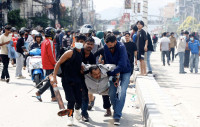Columns
Worsening climate impacts
Floods at the early stages of monsoon weren't common in the past.
Madhukar Upadhya
Come June, worry sets in for those living in the hills along the river banks or flood plains as to how this year's monsoon will fare. This is an unsurprising concern, considering how floods and landslides are recurrent threats during the rainy season in Nepal. National statistics reveal that these disasters cause an average of about 300 people to lose their lives and hundreds to become homeless every year. The loss of hundreds of hectares of crops drives poverty even deeper into the most affected communities. This monsoon seems to be even more worrisome because it will likely bring more rain to several parts of the country.
The extreme events of floods and droughts caused by the changing climate are occurring more frequently than anticipated. Considering how rainfall patterns in recent years have increasingly been dominated by high-intensity, short-duration rains, the havoc likely to be created by above-average rain will undoubtedly be severe. It’s time to pause and mull over why our approach to addressing floods and landslides has been ineffective and lacking.
Government’s preparation
As the National Disaster Risk Reduction and Management Authority specified, as many as 1.8 million people across the country could be vulnerable this year. The government must prepare to rescue potentially 18,000 families. This is the first time the government has scrounged up a plan to rescue an estimated number of people should the disaster strike. Major political parties have even agreed to prepare volunteers who could be mobilised as and when needed to support this plan.
Arrangements have been made to halt the Melamchi project water supply to save the tunnel from filling with sediment if the river experiences high floods—a costly lesson the project learned two years ago when heavy rain in the head watershed area deposited massive amounts of debris in the river bed, burying the project's intake.
Encouraged by the success of the Early Warning System (EWS) application in saving lives and property during the floods in Tarai, the government has also announced developing an ambitious early warning system for multiple hazards—landslides, avalanches, wildfires and air pollution—in the next few years at an estimated cost of Rs81 billion.
These welcome initiatives demonstrate the government's prioritising the reduction of disaster risks and Nepal's progress in making preparations to reduce disaster risks. However, the scale and nature of the climate risks we face are challenging in their complexity and, therefore, can only be addressed in their entirety by adopting a two-pronged approach: Mainstreaming climate change in our development plans rather than on ad hoc or project basis and changing the old practice to match the newly developing climate scenario. Unfortunately, this isn't happening. How we have acknowledged climate-related issues in the most crucial sector of agriculture shows this disconnect.
The disconnect
The second National Climate Change Survey (NCCS) report published last month was a timely reminder of the concerning scenario facing us. Disasters have continually hit much of Nepal’s agriculture in the previous 25 years. Droughts have emerged as a major problem impacting nearly 45 percent of households, followed by floods affecting about 14 percent. Wind storms have battered farms of roughly 10 percent of farming households. Water sources in and around villages have dried up or are drying across the country, irrespective of geographical region, primarily affecting food production. Many farmers have also reported an increase in the number and variety of insects and diseases affecting crops. However, when the government announced its federal budget on May 28, there was no mention of any of these signature climate impacts on Nepal’s agriculture, let alone any semblance of a plan to address them.
One can argue that the preparation of plans for agriculture falls on the local governments, but climate change is also a national issue and one would expect a national agenda, particularly what the federal government hopes to achieve through its budget. The budget, now being deliberated on in the federal parliament, is likely to pass without any member of parliament raising any questions, based on the findings of the NCCS, about the climate impacts on agriculture. If such findings aren’t the bedrock of policymaking and planning, suffice it to say surveys will become meaningless.
Irrespective of the government's priorities, the incoming above-average rain will hit every sector, including agriculture and crop production. But what kind of impacts do we expect? How will the location-specific impacts on crops pose different challenges for different demographics? Knowledge about and an understanding of the anticipated impacts and the affected communities in those areas would help prepare for such eventualities. However, there is no such information available. Agriculture continues to be the least prioritised in our climate discourse for an obvious reason—our reduced dependence on it. With the economic base shifting from farm-based income to remittance for many, the state hasn’t felt the full brunt of the unending climate impacts on agriculture, a key economic sector.
Furthermore, the budget failed to acknowledge the climate impacts on agriculture because climate change is still dealt with in isolation, despite efforts over the decade to make it part of plans and budgets of all climate-relevant sectors, including agriculture. With the current trend and pace, it can be said that we aren’t on the right path for adaptation.
Reevaluating our approach
Climate scientists have been warning us of the accelerating climate impacts, and we see them unfolding. In the past few years, heavy rains causing damaging floods and landslides have been experienced even before the fully active monsoon. In May 2020, Panauti, a small historical town east of Kathmandu, witnessed unexpected floods; on June 16, 2021, heavy rains damaged Melamchi Valley. Floods and landslides also caused fatalities and destroyed homes in several districts in the second week of June 2022. In 2023, about 30 hydropower projects in eastern Nepal suffered damages from floods. Further, heavy rains were reported on June 12, 2024, causing landslides and floods, damaging a few homes in east Nepal.
Such floods at the early stages of monsoon weren't common in the past. Our efforts haven't been in tune with the pace at which devastating climate impacts are being experienced. As a result, no concrete actions are being taken to address the developing scenario except for some symbolic, palliative gestures. The NCCS told us exactly how the changing climate is hurting us and who stands to suffer the most. The (failing) conventional approach to address the issue must change now.




 16.12°C Kathmandu
16.12°C Kathmandu















